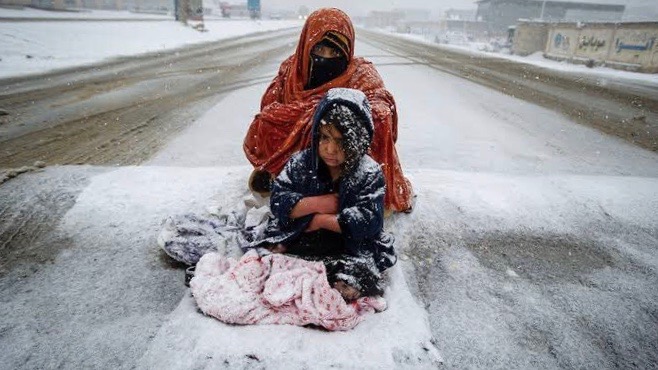As the mercury has dropped to minus 33 degrees Celsius in several provinces in Afghanistan, at least 70 people are reported to have frozen to death in the country. Over the last two weeks, the extreme cold has also killed more than 70,000 livestock, the State Ministry for Disaster Management has reported.
Several weather experts have indicated that due to the southern shift of the northern polar vortex (the area of low pressure and cold air that swirls around the earth’s north pole), several parts of the Himalayas and northern Europe are witnessing one of the worst winters on record. The reasons behind the polar vortex shift, experts highlighted, were “global warming and climate change.”
Mullah Jan Sayeq, Director of Risk Reduction of the State Ministry for Disaster Management, said “people are having a lot of problems due to freezing weather in the country.”
Bibi Gul, a resident of Jawzjan, told Tolo news, “there is no job in this cold weather. Everyone has five to six children and people are unemployed.” Another resident of the Faryab area, Feda Mohammad, said that the cold weather has “affected all the poor people and there is no one in the city. All the stores are closed and there is no fuel.”
“Two of my sons work as day laborers, but they don’t make more than 150 Afghanis ($1.68) a day; not even enough to buy food for the day. It has been months since we tasted a fruit or meat,” said 54-year-old Shahin, a driver from Baghlan, as per Al Jazeera.
According to Afghanistan’s National Disaster Management Agency, more than 70 people have died as a result of the cold snap and snow, with a lot more livelihoods affected.
— BILAL SARWARY (@bsarwary) January 19, 2023
Since August 2021, four out of five households in the country have either witnessed significant decrease in their income, or have been without income at all. Tens of thousands of people are suffering, as acute poverty means that they cannot afford essentials such as fuel and food.
The aftermath of decades of war has further contributed to the humanitarian crisis. Afghanistan’s economy, prior to the Taliban takeover, was largely dependent—about 75%—on foreign donors. Millions of workers in Afghanistan across various sectors of the economy used to draw their salaries from the Afghanistan Reconstruction Trust Fund, until the US instructed the World Bank to stop disbursing this money after the Taliban takeover of the country.
After Afghanistan’s Central Bank was cut off from the international banking system, most of the country’s institutions that relied on the banking system completely collapsed. Afghanistan has been experiencing a “massive liquidity crisis, shortage of bank notes, spiking prices.” On the ground, this meant that millions of daily wage workers were losing their wages on a daily basis. This, of course, has only been complicated by the Taliban’s proscription on some female workers. The NGOs that employed female staff have had to stop their humanitarian and other work, and the workers themselves are unable to earn for themselves. Some of them later resumed work after receiving assurances from the Taliban that women would be allowed to work.
On the one hand, the Taliban regime has struggled to sustain the national economy after taking control 18 months ago—especially after the US seized $7 billion worth of Afghanistan’s assets in early 2022—and, on the other, the people of Afghanistan have been grappling with natural disasters such as earthquakes, floods, and drought, and now the severe cold wave.
The plight of Afghans is doubly perilous during the winter, especially because, as the UN has noted, over 90% of Afghanistan’s population of nearly 40 million lives in poverty, and around 28 million depend on humanitarian aid for their essentials.





